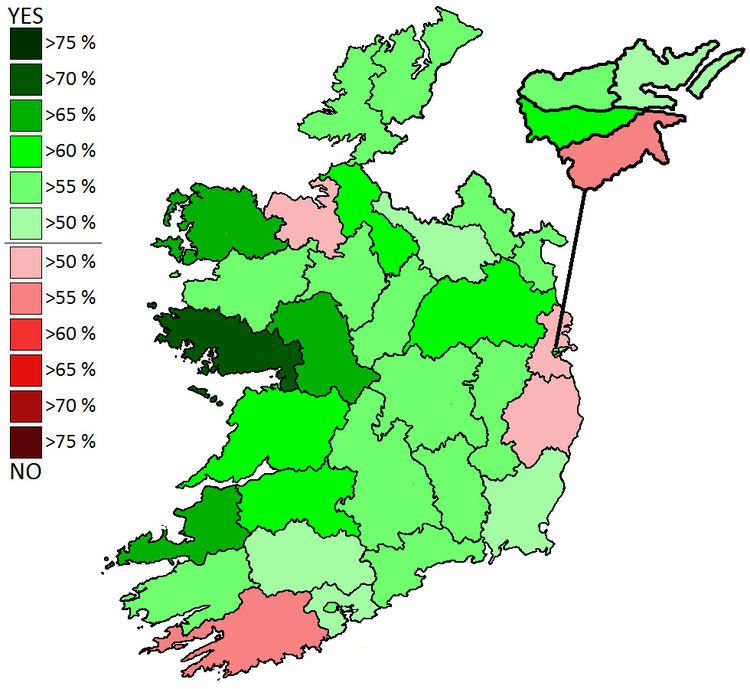Yes 685,105 Valid votes 1,212,050 | No 526,945 | |
 | ||
685,105 7001565200000000000♠56.52% 526,945 7001434800000099999♠43.48% 1,212,050 7001900300000000000♠90.03% | ||
The Constitution of Ireland plebiscite, also known as the Plebiscite on the Draft Constitution, was a plebiscite held in the Irish Free State to approve the adoption of a new constitution for the country. The vote was held on 1 July 1937, the same day as the general election. It was passed by a plurality, with 56% of voters in favour, comprising 38.6% of the whole electorate. As a result, the current Constitution of Ireland came into effect on 29 December 1937, ending the Irish Free State. It was the only plebiscite to take place in the Irish Free State. It was also the only referendum that was officially called a plebiscite in the history of the country; all subsequent votes of this nature have taken place under the provisions of the current Irish constitution and are referred to as referendums.
Contents
Background
The desire to replace the Constitution of the Irish Free State was motivated largely by the association of the existing constitution with the Anglo-Irish Treaty, and a belief that it had been imposed upon Ireland by the government of the United Kingdom. The main opponents of the Treaty had been elected to power as Fianna Fáil under Éamon de Valera in 1932, and a commitment was made to replace the constitution of the Free State. So closely tied to the policies of Fianna Fáil was the proposed new constitution that the 1937 referendum has been described as a vote of confidence in the republican government. After a new constitution was drafted by John Hearne, supervised by de Valera, the draft was accepted by the Oireachtas. The Oireachtas passed the Plebiscite (Draft Constitution) Act 1937, which allowed for a plebiscite to be held so that the people of Ireland could either accept or reject the new constitution.
Supporters of replacing the Irish Free State Constitution were largely sympathetic to the Fianna Fáil party, or republicans who believed in removing the remaining constitutional and legal links to the British state. Opponents of the new constitution included a coalition of supporters of Fine Gael and the Labour Party, and unionists who were concerned about permanently losing the last vestiges of Britain's influence on the institutions of Irish government. The National University Women Graduates' Association opposed the new constitution on the basis that it could undermine women's rights and privacy in the home.
The vote
Voting took place on 1 July 1937, on the same day as the 1937 Irish general election. Voter turnout was 75.84%
The question put to the electorate was, "Do you approve of the Draft Constitution which is the subject of this plebiscite?"
Result
The result of the plebiscite was a clear vote in support of the adoption of the new constitution. Over 56% of voters were in favour. With the turnout, this did not represent a majority of the electorate, but a clear enough plurality for the draft constitution to be deemed to have been approved by the people. The number of invalid or blank votes was high, at almost 10% of the total votes cast (and almost six sevenths of the size of the 'yes' majority).
The 'yes' vote won a majority in all but five of the thirty four constituencies, representing a solid level of support across Ireland. In a further six constituencies (Cavan, Cork North, Cork South-East, Leitrim, Roscommon, and Wexford), the majority for 'yes' was less than the number of spoilt votes (spoilt votes also exceeded the 'no' majority in four of the five constituencies that voted 'no', the exception being Dublin Townships). Geographically, the 'no' vote was strongest in the east coast constituencies of Dublin County and Wicklow, and in Cork West. The draft constitution had least support in Dublin Townships, and gained most support in Galway West, where three quarters of voters backed the proposal. The plebiscite vote was heavily influenced by party political loyalties. Fianna Fáil voters overwhelmingly voted 'yes', while Fine Gael voters and Protestants largely voted 'no'. The bulk of Labour voters supported the new constitution, despite the opposition of the party leadership.
